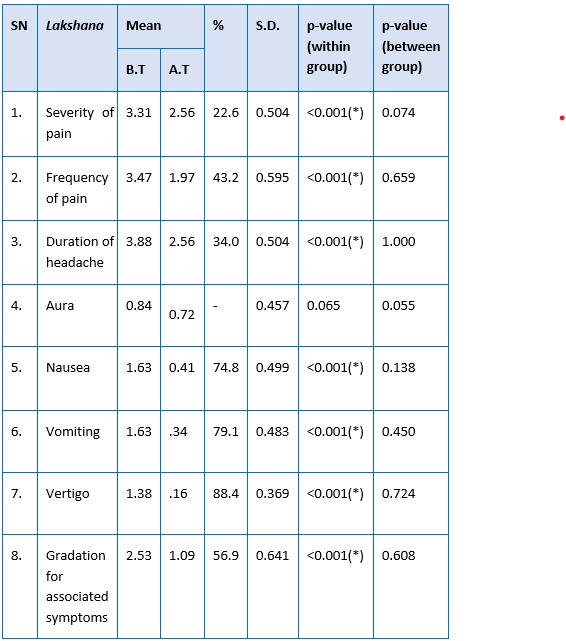A comparative evaluation on efficacy of Brihat Dashmoola Taila Snehapana and Brihat Dashmoola Taila Nasya in the management of Ardhavabhedaka (Migraine)
DOI:
https://doi.org/10.21760/jaims.8.9.3Keywords:
Ardhavabhedaka, Brihat Dashamoola Taila, Migraine, Nasya, SnehapanaAbstract
Migraine is a genetically influenced complex disorder characterized by episodes of moderate-to-severe headache, most often unilateral and generally associated with nausea and light and sound sensitivity. Around 15% of women and 6% of men experience migraines, the second most prevalent type of cerebral pain. The majority of those affected by the disease are in their prime age, or between the second and fifth decade, which has an impact on their professional and social lives and deteriorates their health. Ardhavabhedaka is technically comparable to migraine due to its paroxysmal nature and distinctive characteristic of a "half-sided headache". Material and Methods: In this study, eligible 64 patients were selected and randomly divided in two groups through computer generated randomization. Brihat Dashmoola Taila Snehapana was given in trial group and Brihat Dashmoola Taila Nasya was given in control group for 2 settings of 7 days with 7 days gap. The primary outcomes measured were percentage changes in chief complaints and associate complaint of Ardhavabhedaka in comparison to both groups. Result: Regarding effect of therapy on Chief complaints in trial group, 22.6% relief was found in severity of headache, 34.0% in duration of headache and 43.2% in frequency of headache. In control group, 32.8% relief was found in severity of headache, 32.8% in duration of headache and 45.4% in frequency of headache. Conclusion: The Nasya Karma is a better treatment option in the management of Ardhavbhedaka as compared to Snehapana. Although both the treatments are having statistically significant results.
Downloads
References
Peter J. Goadsby, Neil H. Raskin- Headache, Harrison’s Principles of Internal Medicine 18th edition Volume 1, Mc Graw Hill, page no.114
Ibid Chakrapani, Charak Samhita Sutrasthana 7/16. P.49.
Shastri KA. Shirorogavigyaniyaadhyaya 25/15. In: Sushruta Samhita of Maharshi Sushruta. Varanasi: Chaukhambha Sanskrit Sansthan; 2012. p. 166.
Tripathi B. 23/7-8. In: Ashtanga Hridyayam of Srimadavaghbhata. Varanasi: Chaukhambha Sanskrit Pratishtana; 2003. p. 726.
Shastri SN. Trimarmiyasiddhi 9/75-76. In: Charak Samhita of Agnivesha. Varanasi: Chaukhambha Bharti Academy; 2018. p. 1067.
Kaushik K. P. Shirorogaadhikar 729. In: Bhaishjya Ratnavali; p. 1024.
Murthy KRS. Snehpana Vidhi 1/7. In: Sharangdar Samhita by Sharangadhara. Varanasi: Chaukhambha Orientalia; 2102. p.188.
Murthy KRS. Nasyaa Vidhi 8/25 In: Sharangdar Samhita by Sharangadhara. Varanasi: Chaukhambha Orientalia; 2102. p.225.
Shweta Mata, Vaghela D.B., Shivshankar Rajput et.al. “Comparative clinical study of ayurvedic treatment and conventional standard treatment in the management of Ardhavabhedaka (migraine)-a randomized controlled trial” World Journal of Pharmaceutical Research, 2020.
Shastri SN. Trimarmiyasiddhi 9/75. In: Charak Samhita of Agnivesha. Varanasi: Chaukhambha Bharti Academy; 2018. p. 1067.
Shastri KA. Vatavyadhi Nidana 01/34. In: Sushruta Samhita of Maharshi Sushruta. Varanasi: Chaukhambha Sanskrit Sansthan; 2018. p. 299.
Shastri KA. Vatavyadhi Nidana 01/35. In: Sushruta Samhita of Maharshi Sushruta. Varanasi: Chaukhambha Sanskrit Sansthan; 2018. p. 299.
Shastri KA. Garbhavyakarna Sharir 04/55. In: Sushruta Samhita of Maharshi Sushruta. Varanasi: Chaukhambha Sanskrit Sansthan; 2018. p. 48
Shastri SN. Trimarmiyasiddhi 9/77. In: Charak Samhita of Agnivesha. Varanasi: Chaukhambha Bharti Academy; 2018. p. 1067.















